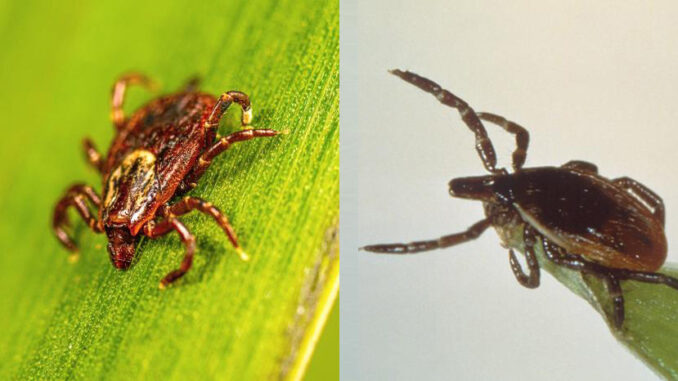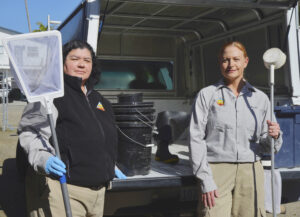
Mosquitoes aren’t the only danger—Santa Barbara County residents also need to watch for ticks and rodents that can spread serious diseases
by Elizabeth Ann Morabito
For centuries, people believed rats were responsible for the bubonic plague that wiped out millions in medieval Europe. But the real culprit? Fleas.
Fleas pick up the plague-causing bacteria when they bite the infested rats. Humans are then infected when bitten by fleas. Fleas are the vectors whereas rodents are the hosts.
“We’re strictly concerned with insects like mosquitoes or other vectors, which are anything that can bite or sting and transmit disease organisms,” explains Brian Cabrera, general manager at the Mosquito & Vector Management District of Santa Barbara County (MVMD).
We’re strictly concerned with insects like mosquitoes or other vectors, which are anything that can bite or sting and transmit disease organisms.
Brian Cabrera, general manager at MVMD
While mosquitoes are the most well-known vectors, they’re far from the only threat. MVMD plays a critical role in protecting residents and their pets from a variety of pests that can spread disease. Left unchecked, vector populations can surge quickly—putting public health at risk.
Rodents are one of the other vectors MVMD monitors. In some areas, it tracks rodent populations, responds to reported infestations, coordinates with public health officials, educates the community, and provides rodent control advice.

from pests that are not just a nuisance but can
also cause harm
Photo credit Nell Campbell
“We go out to people’s houses and look for the rodent entry points… and advise how to block it off, what kind of repairs need to be done, and how to use snap traps,” shares Karen Schultz, vector biologist technician at MVMD.
MVMD also partners with the California Department of Public Health for annual rodent disease surveillance—critical work that helps prevent outbreaks before they happen.
“About once a year, the state biologists come up to our county and we help them trap squirrels,” Schultz explains. “And they take the fleas off and take a blood sample to test for plague.”
She’s quick to add that the squirrels are carefully anesthetized and treated gently: “They’re put in a little shady spot and eventually wake up.”
Fast Facts About Rodents & Fleas:
- Where they thrive: Areas with food, water, and shelter—urban zones, woodlands, and farmland
- Active season: Year-round, with increased indoor activity during cooler months
- Risk factor: Fleas can transmit the plague; rodents can spread bacteria and viruses through saliva, urine, droppings, and contaminated dust or soil
- Symptoms: Fever, chills, muscle aches, cough, vomiting, fatigue, and sometimes jaundice
To stay safe, avoid disturbing rodent nests or inhaling dust in rodent-infested areas. Wear gloves and N95 masks when cleaning, wet down dusty areas with a disinfecting spray such as a 10% bleach solution, and thoroughly ventilate and sanitize affected areas.
Another disease-carrying vector MVMD addresses is ticks. While the District doesn’t provide tick removal or direct control services, it does monitor tick-prone areas, collect and test samples, and share public alerts when necessary.
“We let the flag go through the vegetation where we think that ticks will be waiting to find a host. And they grab onto the cloth,” Schultz says of their method—a 9-foot square white flag dragged through grass and brush to catch ticks—for testing.
Fast Facts About Ticks:
- Where they thrive: Vegetated areas—trails, brush, tall grass, leaf litter, logs, and tree trunks
- Active season: Year-round, especially during warmer months
- Risk factor: Ticks can carry Lyme disease, Rocky Mountain spotted fever, and Pacific Coast tick fever
- Symptoms: Fever, headache, fatigue, muscle pain, joint aches, and rash
To prevent bites:
- Wear long pants and sleeves; tuck clothing to cover exposed skin.
- Use EPA-approved insect repellents.
- Avoid walking through tall grass and brush.
- Check pets and people after spending time outdoors, especially in undeveloped or wilderness areas.
- Wash pet bedding often.
If you find a tick, remove it promptly with fine-tipped tweezers. Grasp it close to the skin and pull it out gently. It typically takes 48 hours for ticks to transmit disease, so early removal matters.
By understanding how these vectors operate, residents can take simple, informed steps to stay safe. MVMD can’t do it alone—it takes a community.
“Vector control is a team effort,” Schultz emphasizes.
How you can help keep Santa Barbara County safe:
- Spot unusual mosquito activity? Especially daytime ankle biters? It could be invasive Aedes aegypti—report immediately: mvmdistrict.org/contact-us or call (805) 969-5050.
- See standing water or a neglected pool? Let MVMD know: mvmdistrict.org/contact-us or call (805) 969-5050.
- Found a dead bird? It may be linked to West Nile Virus. Report it to the California Department of Public Health: westnile.ca.gov/report.



